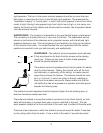
RATTLES
Rattles in the room are structural resonances (as opposed to standing waves, which are
airborne resonances) which the system may stimulate due to its broad frequency
response and wide dynamic range. They are particularly prominent for sounds in the
lower frequencies, and can sound like distortion. Sources of rattles include: furniture,
loose window frames, walls, lighting, fixtures, ventilation systems, and even knick-knacks
on various shelves around the room. The simplest way of identifying these rattles is by
using the Rattle Test found on
WOW! (Chapter 16). This is an extremely slow low fre-
quency sweep from 20 Hz to 500 Hz, recorded at reference level. 10dB of output level
increase over standard level might be necessary to allow hearing all the room rattles. Be
careful with this test, as it is also a severe test of associated amplifiers and speakers.
As the sweep makes its way up the frequency range, you will probably find a surprising
number of rattles in your room. All of these rattles will occur at one time or another during
music or movies, but are usually perceived as background noise or distortion in the system.
Once identified, eliminating the rattles is usually straightforward. As an example, small
pieces of felt can be affixed to the back of a painting (in the bottom corners) to prevent
audible rattles against the wall. Likewise, strips of felt can be wedged into a loose win-
dow rattling in its frame. Recessed lighting fixtures can be tightened up. A piece of
cloth can be placed under offending knick-knacks.
Every Home THX Audio System should be subjected to the rattle test at least once—
the difference in low level resolution and in freedom from pseudo-distortion is some-
times large, and the effort involved is quite small.
BACKGROUND NOISE
The effects of background noise on system performance is dramatic, yet often over-
looked. Most people might think of it merely as a minor inconvenience, yet it has a pro-
found effect on the way we perceive sound.
The presence of more-or-less constant background noise alters the way we perceive
volume, since subjective loudness is a relative measure. In a quiet room, even a 70 dB
SPL sound can seem fairly loud. In a noisy convention center, the same volume would
be barely audible. Since there is a practical upper limit to both the volume to which we
should expose ourselves and to the volume a given system can reproduce, having a
relatively noisy environment effectively limits the perceived dynamic range of the pro-
gram material. This, in turn, limits the dramatic effect which might have been intended
by the director (or the performer, if listening to music).
12


















